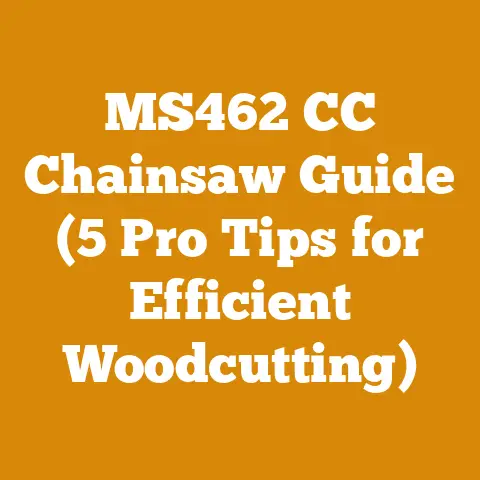Figuring Board Feet in Logs (5 Expert Tips for Accurate Cuts)
Figuring Board Feet in Logs: 5 Expert Tips for Accurate Cuts
Figuring out the board feet in a log is the bedrock of everything from pricing timber to planning your woodworking projects. It’s the key to unlocking the potential within those rough-hewn giants. Whether you’re a seasoned logger, a weekend woodworker, or someone just trying to heat their home efficiently, understanding how to accurately estimate board feet is crucial for making sound financial decisions and maximizing resource utilization. It’s about getting the most bang for your buck, and avoiding costly surprises down the line.
The Importance of Accurate Board Foot Calculation
Why does this matter so much? Think of it this way: if you’re buying logs, you want to know exactly what you’re paying for. If you’re selling, you need to price your product fairly and competitively. And if you’re using logs for your own projects, accurate estimation helps you plan your cuts, minimize waste, and avoid running short on materials.
Inaccurate estimations can lead to significant financial losses, wasted resources, and project delays. Imagine buying a log expecting a certain yield, only to find out later that you’ve overestimated its volume by a significant margin. Or, conversely, underselling a log and missing out on potential profit. It’s a game of precision, and the more accurate you are, the better your results will be.
The Variable Landscape of Wood Processing Costs
Before diving into the nitty-gritty of board foot calculations, it’s essential to acknowledge the swirling vortex of factors that influence the overall cost of wood processing. This isn’t a static, one-size-fits-all situation. The price of wood, the cost of labor, and even the efficiency of your tools can all dramatically impact your bottom line.
-
Wood Species and Quality: The type of wood you’re working with is a major cost driver. High-demand hardwoods like walnut, cherry, and oak command premium prices, while softwoods like pine and fir are generally more affordable. The presence of knots, rot, or other defects also affects the value and usable yield of a log.
-
Location and Accessibility: Where you are in the world, and how easy it is to get to the wood, plays a significant role. Remote areas often incur higher transportation costs, while regions with abundant timber resources may have lower prices.
-
Seasonality: The time of year can also influence wood prices and availability. Logging operations are often affected by weather conditions, and certain species may be easier to harvest or process at specific times of the year.
-
Labor Costs: If you’re hiring a logging crew or firewood handlers, labor costs can be a substantial expense. Wages vary widely depending on location, experience, and the complexity of the job. I’ve seen prices range from \$20/hour for basic firewood handling to \$75+/hour for skilled logging professionals.
-
Tool and Equipment Costs: Chainsaws, splitters, sawmills, and other tools all come with their own price tags and maintenance requirements. The initial investment in equipment, as well as ongoing costs like fuel, oil, and repairs, must be factored into your budget.
-
Permits and Regulations: Depending on your location and the scale of your operation, you may need to obtain permits for logging or wood processing activities. These permits can add to your overall costs and require careful planning.
My Journey with Wood: A Personal Anecdote
I remember my first serious woodworking project like it was yesterday. I was determined to build a dining table from locally sourced walnut. I found a beautiful log at a local sawmill, but I was completely overwhelmed by the process of estimating its board footage. I relied on a rough estimate from the miller, and let’s just say, my budget was in for a rude awakening.
I ended up with significantly less usable lumber than I had anticipated, and I had to scramble to find additional material to complete the project. It was a valuable lesson learned: accurate board foot calculation is not just a technical skill; it’s a crucial element of project planning and cost management.
Unveiling the Board Foot: A Definition
A board foot is a unit of measurement for lumber, representing a piece of wood that is 1 foot long, 1 foot wide, and 1 inch thick. It’s a standard way to quantify the volume of lumber, regardless of its actual dimensions.
Understanding the board foot is crucial for comparing prices, estimating material needs, and calculating the yield of a log. It provides a common language for buyers and sellers in the lumber industry.
Expert Tip #1: Mastering the Doyle Log Scale
The Doyle Log Scale is the most commonly used method for estimating board feet in logs, particularly in North America. While it’s not the most accurate scale (it tends to underestimate the yield of smaller logs), it’s widely accepted and used as a standard in many regions.
The Formula:
Board Feet = (Small End Diameter (inches) - 4)^2 * Length (feet) / 16
Breaking it Down:
- Small End Diameter: Measure the diameter of the log at its smallest end, inside the bark. This is a crucial measurement, as it directly impacts the calculated board footage.
- Length: Measure the length of the log in feet.
- Plug it in: Substitute the diameter and length values into the formula.
Example:
Let’s say you have a log that is 12 feet long and has a small end diameter of 16 inches.
Board Feet = (16 - 4)^2 * 12 / 16
Board Feet = (12)^2 * 12 / 16
Board Feet = 144 * 12 / 16
Board Feet = 108
Therefore, the log is estimated to contain 108 board feet using the Doyle Log Scale.
Limitations:
As mentioned, the Doyle Log Scale tends to underestimate the yield of smaller logs. This is because the formula assumes a significant amount of waste due to the shape of the log and the sawing process. For larger logs, the Doyle Scale is generally more accurate.
Data Point: In a study comparing different log scales, the Doyle Scale was found to underestimate the actual yield of logs with diameters less than 12 inches by an average of 20%.
Expert Tip #2: Exploring Alternative Log Scales
While the Doyle Log Scale is widely used, it’s not the only option. Several other log scales offer different levels of accuracy and are used in different regions. Understanding these alternatives can help you make informed decisions and negotiate fair prices.
- Scribner Log Scale: The Scribner Log Scale is another common method, particularly in the Western United States. It generally provides a more accurate estimate than the Doyle Scale, especially for smaller logs.
- International 1/4-inch Log Scale: This scale is considered one of the most accurate, as it accounts for taper and sawing variations more precisely. It’s often used as a benchmark for comparing other log scales.
- Ontario Log Rule: Used primarily in Ontario, Canada, this rule provides a relatively accurate estimate of board footage.
Why Consider Alternatives?
The choice of log scale can significantly impact the estimated board footage and, consequently, the price of the log. If you’re buying or selling logs, it’s essential to understand which scale is being used and how it affects the valuation.
Data Point: A comparison of log scales found that the Scribner Scale yielded estimates that were, on average, 10% higher than the Doyle Scale for logs with diameters between 8 and 16 inches.
Expert Tip #3: The Importance of Taper Allowance
Logs aren’t perfectly cylindrical. They taper from the butt end (the larger end) to the top end (the smaller end). Accounting for this taper is crucial for accurate board foot estimation.
How to Account for Taper:
- Measure at Both Ends: Instead of just measuring the small end diameter, measure the diameter at both the small end and the large end of the log.
- Calculate the Average Diameter: Average the two diameters to get a more representative value.
- Use the Average Diameter in the Formula: Substitute the average diameter into the log scale formula.
Example:
Let’s say you have a log that is 10 feet long. The small end diameter is 12 inches, and the large end diameter is 18 inches.
- Average Diameter: (12 + 18) / 2 = 15 inches
- Doyle Scale Calculation (using average diameter):
Board Feet = (15 - 4)^2 * 10 / 16 Board Feet = (11)^2 * 10 / 16 Board Feet = 121 * 10 / 16 Board Feet = 75.625
Therefore, the log is estimated to contain approximately 76 board feet using the Doyle Log Scale and accounting for taper.
Why It Matters:
Ignoring taper can lead to significant underestimation of the board footage, especially for longer logs with significant taper. By accounting for taper, you can get a more accurate representation of the log’s potential yield.
Expert Tip #4: Deducting for Defects
Logs are rarely perfect. They often contain defects such as knots, rot, cracks, and insect damage. These defects reduce the usable board footage and must be deducted from the overall estimate.
Identifying Defects:
Carefully inspect the log for any signs of defects. Look for:
- Knots: These are the remnants of branches and can significantly reduce the strength and appearance of the lumber.
- Rot: This is a fungal decay that weakens the wood and makes it unusable.
- Cracks: These can occur due to drying or stress and can compromise the structural integrity of the lumber.
- Insect Damage: Holes and galleries created by insects can weaken the wood and make it unsuitable for certain applications.
Estimating Deductions:
Estimating the amount of board footage to deduct for defects is a subjective process that requires experience and judgment. Here are some general guidelines:
- Knots: Deduct for knots that are larger than 2 inches in diameter or that are clustered together. A good rule of thumb is to deduct the diameter of the knot from the log’s diameter in the board foot formula.
- Rot: Deduct for any areas of rot that are visible on the surface of the log. The amount of deduction will depend on the extent and severity of the rot.
- Cracks: Deduct for cracks that are longer than 1 foot or that penetrate deep into the log.
- Insect Damage: Deduct for areas of significant insect damage.
Example:
Let’s say you have a log that is estimated to contain 100 board feet using the Doyle Log Scale. However, you notice a large knot that is 4 inches in diameter. You decide to deduct 4 inches from the log’s diameter in the formula. This could result in a reduction of 20-30 board feet, depending on the log’s dimensions.
My Experience:
I once purchased a log that looked promising from the outside, but after milling it, I discovered a large pocket of rot in the center. I ended up losing about 40% of the usable lumber due to that defect. This experience taught me the importance of thorough inspection and realistic deduction for defects.
Expert Tip #5: Using Technology to Your Advantage
In today’s digital age, there are numerous tools and resources available to help you accurately estimate board feet in logs. These tools can save you time and effort and improve the accuracy of your calculations.
- Board Foot Calculators: Online board foot calculators can quickly and easily calculate the board footage of a log using various log scales. Simply enter the dimensions of the log, and the calculator will do the rest.
- Mobile Apps: There are several mobile apps available that allow you to measure logs and calculate board footage in the field using your smartphone or tablet. Some apps even use augmented reality to help you visualize the log and estimate defects.
- Laser Measurement Tools: Laser measurement tools can accurately measure the dimensions of logs and transfer the data to a computer for analysis. These tools are particularly useful for large-scale logging operations.
- Sawmill Software: Sawmill software can help you optimize your sawing patterns to maximize the yield of lumber from each log. This software can also track inventory and generate reports on production and costs.
Data Point: A study found that using a laser measurement tool to measure logs resulted in a 5% increase in accuracy compared to manual measurements.
Cost Optimization: A Deep Dive
Now that we’ve covered the technical aspects of board foot calculation, let’s delve into the practical considerations of cost optimization in wood processing and firewood preparation.
1. Timber Purchase or Harvesting Costs:
- Negotiate Prices: Don’t be afraid to negotiate with timber suppliers. Research market prices and be prepared to walk away if the price is too high.
- Consider Alternative Species: If you’re flexible on the type of wood you use, consider alternative species that may be more affordable.
- Harvest Your Own Timber (if possible): If you have access to land with trees, harvesting your own timber can significantly reduce your costs. However, be sure to obtain any necessary permits and follow sustainable forestry practices.
- Data Point: Average stumpage prices (the price paid for standing timber) vary widely depending on species and location. For example, walnut stumpage in the Midwest United States can range from \$500 to \$2,000 per thousand board feet.
- Volume Discounts: Many suppliers offer discounts for purchasing larger quantities of timber.
2. Labor Wages:
- Hire Experienced Workers: While experienced workers may command higher wages, they can often complete the job more quickly and efficiently, ultimately saving you money.
- Consider Piece-Rate Pay: Instead of paying hourly wages, consider paying workers on a piece-rate basis (e.g., per cord of firewood split). This can incentivize productivity and reduce labor costs.
- Invest in Training: Providing training to your workers can improve their skills and efficiency, leading to lower labor costs.
3. Tool Maintenance:
- Regular Maintenance: Performing regular maintenance on your tools can prevent breakdowns and extend their lifespan, saving you money on repairs and replacements.
- Sharpen Chainsaws Regularly: A sharp chainsaw cuts faster and more efficiently, reducing fuel consumption and operator fatigue.
- Use High-Quality Fuel and Oil: Using high-quality fuel and oil can improve the performance and longevity of your tools.
- Data Point: The average cost of chainsaw maintenance is approximately \$50 per year, but this can vary depending on the frequency of use and the type of chainsaw.
4. Drying Costs:
- Air Drying: Air drying is the most cost-effective method of drying lumber, but it can take several months or even years.
- Kiln Drying: Kiln drying is a faster method of drying lumber, but it requires specialized equipment and can be more expensive.
- Data Point: The cost of kiln drying lumber can range from \$0.25 to \$1.00 per board foot, depending on the species and the drying schedule.
- Optimize Drying Conditions: Proper air circulation and stacking techniques can speed up the air drying process and reduce the risk of warping or cracking.
- Calculate Drying Time: Drying time depends on wood species, thickness, and environmental conditions. Softwoods typically dry faster than hardwoods. A rule of thumb is that 1-inch hardwood boards take about one year per inch of thickness to air dry in moderate climates.
5. Transportation Costs:
- Minimize Transportation Distance: Source timber and equipment locally whenever possible to minimize transportation costs.
- Consolidate Shipments: Consolidate shipments of timber and equipment to reduce transportation costs.
- Negotiate Shipping Rates: Negotiate shipping rates with trucking companies or freight brokers.
6. Permits and Regulations:
- Research Permit Requirements: Research the permit requirements for logging and wood processing activities in your area.
- Obtain Necessary Permits: Obtain all necessary permits before starting any work to avoid fines and legal issues.
- Comply with Regulations: Comply with all applicable regulations to protect the environment and ensure worker safety.
Case Study: Budgeting for a Firewood Preparation Project
Let’s consider a case study of budgeting for a firewood preparation project. Suppose you want to prepare 10 cords of firewood for the winter.
Cost Breakdown:
- Timber Purchase: Assuming you purchase standing timber for \$50 per cord, the timber cost would be \$500.
- Labor Costs: If you hire someone to fell the trees and buck them into logs at \$30 per hour and it takes 2 hours per cord, the labor cost would be \$600.
- Splitting Costs: If you rent a log splitter for \$100 per day and it takes 2 days to split all the wood, the rental cost would be \$200.
- Transportation Costs: Assuming you need to haul the logs a short distance at \$50 per load and it takes 2 loads per cord, the transportation cost would be \$1,000.
- Miscellaneous Costs: Add a contingency for miscellaneous costs such as fuel, oil, and repairs (say, \$100).
Total Estimated Cost: \$500 (timber) + \$600 (labor) + \$200 (splitter rental) + \$1,000 (transportation) + \$100 (miscellaneous) = \$2,400
Cost per Cord: \$2,400 / 10 cords = \$240 per cord
Industry Benchmark: The average price for a cord of seasoned firewood can range from \$150 to \$400, depending on location, wood species, and the seller. This means you’d be at the higher end of the spectrum, so finding ways to reduce costs is essential.
Cost Optimization Tips:
- Fell the Trees Yourself: If you’re comfortable and have the necessary equipment, felling the trees yourself can save you \$600 in labor costs.
- Split the Wood Manually: Splitting the wood manually with a maul can save you \$200 in splitter rental costs.
- Negotiate Transportation Rates: Shop around for the best transportation rates and consider using a smaller truck to reduce costs.
Actionable Takeaways and Next Steps
Figuring board feet in logs and effectively managing wood processing costs requires a blend of technical knowledge, practical experience, and careful planning. By mastering the techniques outlined in this article, you can make informed decisions, optimize your resource utilization, and achieve your woodworking or firewood preparation goals.
Next Steps:
- Practice Measuring Logs: Get some practice measuring logs and calculating board footage using different log scales.
- Inspect Logs Carefully: Develop a keen eye for identifying defects and estimating deductions.
- Research Local Timber Prices: Stay informed about current timber prices in your area.
- Develop a Detailed Budget: Create a detailed budget for your next wood processing or firewood preparation project.
- Explore Technology Solutions: Investigate the various technology solutions available to help you streamline your operations and improve accuracy.
Remember, success in wood processing and firewood preparation is a journey. Embrace the learning process, stay adaptable, and never stop seeking ways to improve your skills and efficiency. With dedication and a bit of elbow grease, you can unlock the full potential of your wood resources and achieve your goals. Now go forth and conquer those logs!






